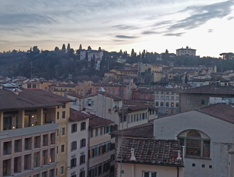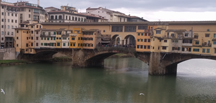 Europe in winter is great for the relative lack of tourists, the trade-off being cold and often wet weather—an exchange we’re happy to make. We arrive Christmas Day in Florence, and overnight in an Arno-view suite at the very lovely Hotel Lungarno, one of a quartet of design hotels clustered around the Ponte Vecchio owned by the Ferragamo family.
Europe in winter is great for the relative lack of tourists, the trade-off being cold and often wet weather—an exchange we’re happy to make. We arrive Christmas Day in Florence, and overnight in an Arno-view suite at the very lovely Hotel Lungarno, one of a quartet of design hotels clustered around the Ponte Vecchio owned by the Ferragamo family.
We have rented (for the second time in a decade) an incredible renaissance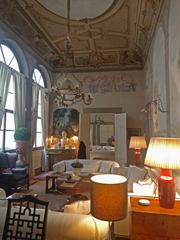 apartment on the piano nobile of an old palazzo on Via della Vigna Vecchia, very near Piazza della Signoria, owned by noted Italian architect and designer Michele Bönan. The main salon is 15 by 40 feet with 20 foot high domed, frescoed ceiling, and five tall, arched windows with swagged drapes looking out onto the palazzo courtyard. Stone pilasters separate the windows, and the entire main wall opposite is trompe l’oeil as of a distant lake and hillside scene through arched columns. The bedroom was originally a 20 by 40 foot room with similar high ceilings, though coffered in wood, and a bathroom and kitchen have been created between the two main rooms, with a resulting loft study on top, reached by an iron stair at the end of the bedroom. The bath and kitchen
apartment on the piano nobile of an old palazzo on Via della Vigna Vecchia, very near Piazza della Signoria, owned by noted Italian architect and designer Michele Bönan. The main salon is 15 by 40 feet with 20 foot high domed, frescoed ceiling, and five tall, arched windows with swagged drapes looking out onto the palazzo courtyard. Stone pilasters separate the windows, and the entire main wall opposite is trompe l’oeil as of a distant lake and hillside scene through arched columns. The bedroom was originally a 20 by 40 foot room with similar high ceilings, though coffered in wood, and a bathroom and kitchen have been created between the two main rooms, with a resulting loft study on top, reached by an iron stair at the end of the bedroom. The bath and kitchen 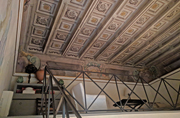 are small, but fully functional, and the whole is simply spectacular...the apartment is studded with art and antiques, and a trio of elegant sofas in the center of the room provide the living focal point. Bönan's own apartment is across the hall, and even more spectacular.
are small, but fully functional, and the whole is simply spectacular...the apartment is studded with art and antiques, and a trio of elegant sofas in the center of the room provide the living focal point. Bönan's own apartment is across the hall, and even more spectacular.
Tuesday is another holiday, the feast of St. Stephen, with all shops and businesses closed, so we wander the renaissance city with the hundreds of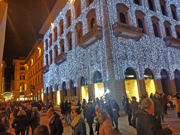 families and lovers and travelers, window shopping and taking in the ancient and historic palazzi and piazzi of Florence. The historic Café Gilli sits on the corner of the Piazza Republica, and at dusk we sip an icy vodka Martini while watching the passing parade admiring the 50-foot Christmas tree and the thousands of twinkling white lights strung around the piazza. All of the streets are festooned with lighted decorations – arches, stars, garlands and more.
families and lovers and travelers, window shopping and taking in the ancient and historic palazzi and piazzi of Florence. The historic Café Gilli sits on the corner of the Piazza Republica, and at dusk we sip an icy vodka Martini while watching the passing parade admiring the 50-foot Christmas tree and the thousands of twinkling white lights strung around the piazza. All of the streets are festooned with lighted decorations – arches, stars, garlands and more.
In our meandering we spot an authentic looking trattoria called Il Paiolo in Via Corso, which trumpets Chianina beef, and has huge sides of aged porterhouse hanging in a refrigerated glass case streetside. There is a 15-minute wait, 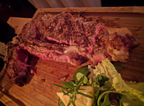 standing in the street, and we are given a glass of prosecco to help pass the time. It’s a crowded restaurant, with close, cramped tables, and we are seated inches from an Italian bella figura woman with a curly putti-locked son. As we peruse the menu, they are delivered a huge slab of sizzling steak, carved tableside, and that cements our decision. We order the Bistecca alla Fiorentino, over a kilo of chianina beef weighed and presented for approval before grilling – at €8.5 l’etto (10 etti per Kilo) that’s a $130 steak, at the still-worsening dollar/euro exchange rate. Served with grilled vegetables and roast potatoes, the steak is cooked dead rare, and is tender and juicy, but somewhat less flavorful than we expected. We take more than half home to be re-purposed in our tiny kitchen.
standing in the street, and we are given a glass of prosecco to help pass the time. It’s a crowded restaurant, with close, cramped tables, and we are seated inches from an Italian bella figura woman with a curly putti-locked son. As we peruse the menu, they are delivered a huge slab of sizzling steak, carved tableside, and that cements our decision. We order the Bistecca alla Fiorentino, over a kilo of chianina beef weighed and presented for approval before grilling – at €8.5 l’etto (10 etti per Kilo) that’s a $130 steak, at the still-worsening dollar/euro exchange rate. Served with grilled vegetables and roast potatoes, the steak is cooked dead rare, and is tender and juicy, but somewhat less flavorful than we expected. We take more than half home to be re-purposed in our tiny kitchen.
Florence is really a small and eminently walkable city. In five minutes we are at Piazza Della Signoria, with Michaelangelo's David, the Palazzo Vecchio, and the Uffizi Museum. Five minutes further the famous Ponte Vecchio straddles the Arno, lined with goldsmith shops that date to the renaissance. Ten minutes northward we can be at the Piazza del Duomo, with Giotto’s Tower and the Baptistry. Eight blocks west are the elegant shopping streets of Via Porta Rossa and Via Tournabuoni.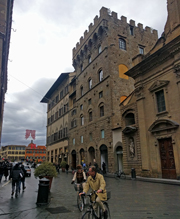
Two blocks up Vigna Vecchia is the Piazza di San Firenze, over which brood the Palazzo Gondi, staring across at one of the few baroque buildings in Florence, previously the Tribunal of the city and originally a convent. Just down from our corner is the 13th century crenellated tower-fortress housing the Bargello Museum, one of the most under-visited in Florence, with perhaps the best collection of sculpture in the city...which is saying something.
Via Porta Rosa is a curving street set with elegant smaller and artisanal shops...much leather, Borsalino’s famous hats, small design boutiques and a lovely hand-made paper store. Midway on the south side sits the imposing Palazzo Davanzati, which dates originally to the 1400’s. Four stories of brown sandstone, the palace is topped with an open loggia with sweeping views of the 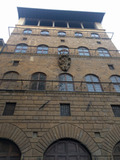 city. A 6€ ticket provides access to the first three floors, and a view into the upper crust renaissance Florentine lifestyle. A 10-minute video presents the history of the palace, its various incarnations and renovations, and the context that it’s one of a very few buildings of its era in this area of Florence to survive a late 1800’s modernization craze that destroyed much historic architecture.
city. A 6€ ticket provides access to the first three floors, and a view into the upper crust renaissance Florentine lifestyle. A 10-minute video presents the history of the palace, its various incarnations and renovations, and the context that it’s one of a very few buildings of its era in this area of Florence to survive a late 1800’s modernization craze that destroyed much historic architecture.
At Piazza Trinita, the flagship Ferragamo Store takes up the  entire ground floor of the gothic 13th century Palazzo Spini Feroni. Every item of clothing and shoes, men and women, produced by the company must be on exhibit in this enormous emporium. There
entire ground floor of the gothic 13th century Palazzo Spini Feroni. Every item of clothing and shoes, men and women, produced by the company must be on exhibit in this enormous emporium. There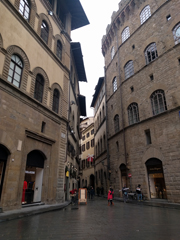 is a new section in the ladies shoe complex called Ferragamo Creations that features limited edition reproductions, each individually numbered, of footware from the past. The basement houses the
is a new section in the ladies shoe complex called Ferragamo Creations that features limited edition reproductions, each individually numbered, of footware from the past. The basement houses the 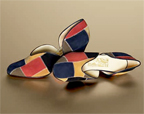 Photo: FerragamoSalvatore Ferragamo Museum, which contains over 15,000 pair of shoes designed by Ferragamo since the 1920’s, tons of Ferragamo memorabilia, and a most interesting display of Italian art and sculpture.
Photo: FerragamoSalvatore Ferragamo Museum, which contains over 15,000 pair of shoes designed by Ferragamo since the 1920’s, tons of Ferragamo memorabilia, and a most interesting display of Italian art and sculpture.
From Piazza Trinita, Via Tournabuoni leads north, and houses the upscale shopping section of Firenze, with the boutiques of Balenciaga, Cartier, Bulgari, Gucci, Armani and more. These luxury stores are in keeping with the history the street, as the renaissance pallazi of the wealthy Medici, Strozzi, Tournabuoni, Larderel and Minerbetti tower over the wide avenue.
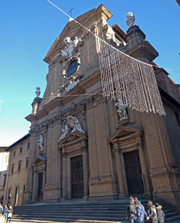 For architecture, Florence is a city like few others: of course fabulous churches—Santa Maria Novella, Santa Croce, and San Lorenzo, in addition to the iconic Duomo. There are a few remaining medieval tower-houses, and these imposing palaces of wealthy Florentine merchants and royalty. Palazzo Strozzi lords over Via Tournabuoni with its huge cushion shaped stones at the ground level, and increasingly refined blocks as the levels rise, in the classic rennaisance palazzo style. The lower walls are festooned with enormous torchieres and iron rings to tie up horses, dotted along at ten feet high or so. A colonnaded courtyard sits inside the enormous bronze-studded arched wood doors, overlooked by a second-story portico.
For architecture, Florence is a city like few others: of course fabulous churches—Santa Maria Novella, Santa Croce, and San Lorenzo, in addition to the iconic Duomo. There are a few remaining medieval tower-houses, and these imposing palaces of wealthy Florentine merchants and royalty. Palazzo Strozzi lords over Via Tournabuoni with its huge cushion shaped stones at the ground level, and increasingly refined blocks as the levels rise, in the classic rennaisance palazzo style. The lower walls are festooned with enormous torchieres and iron rings to tie up horses, dotted along at ten feet high or so. A colonnaded courtyard sits inside the enormous bronze-studded arched wood doors, overlooked by a second-story portico.
Midway up the street, Procacci, a small jewel of a wine bar, owned by the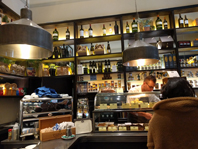 Antinori family, serves pastries, small plates and tiny sandwiches. We select a glass of Prosecco, one of pink sparkling Franciacorta and small rolls filled with gorganzola and fig jam, prosciutto and cheese.
Antinori family, serves pastries, small plates and tiny sandwiches. We select a glass of Prosecco, one of pink sparkling Franciacorta and small rolls filled with gorganzola and fig jam, prosciutto and cheese.
A few blocks from the top of the Tournabuoni sits Brunelleschi’s Basilica di San Lorenzo, Florence’s original cathedral, with it’s two capelle of the Medici family, in whose crypt almost all of the Medici family members are buried. A 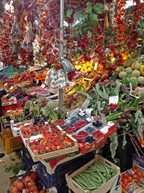 few blocks further we come to the vast cast-iron and glass Mercato Centrale, originally built in 1874. The market has changed since we last visited a dozen years ago. The ground floor is still meat, fish, salumeria, vegetables, but the entire top deck, which used to be given over to more market vendors, was converted in 2014 into an enormous food hall, with cooked foods of every description, from asparagus risotto to roast chicken to fritto misto to Chianina beef burgers, and hundreds of tables crammed with lunchers. There are also specialty food vendors, an Eataly grocery section, enoteca and a cooking school.
few blocks further we come to the vast cast-iron and glass Mercato Centrale, originally built in 1874. The market has changed since we last visited a dozen years ago. The ground floor is still meat, fish, salumeria, vegetables, but the entire top deck, which used to be given over to more market vendors, was converted in 2014 into an enormous food hall, with cooked foods of every description, from asparagus risotto to roast chicken to fritto misto to Chianina beef burgers, and hundreds of tables crammed with lunchers. There are also specialty food vendors, an Eataly grocery section, enoteca and a cooking school.
That evening we dine at a small wood paneled restaurant in Via Porta Rosa called Il Barretto. The glowing wood walls, low tables, and small wooden captain’s chairs are quite reminiscent of Harry’s bar in Venice. Very friendly and efficient service brings a sformatta di verdure with Gorgonzola sauce, and perfect fresh shrimp, followed by spaghetti carbonara and vitello ala Milanese.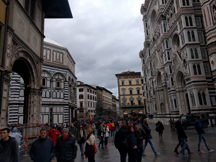
The second to last afternoon of 2017 we meet Giaccomo, a tall handsome 30-something fellow at Piazza Della Signoria for an “inferno” tour, referring both to Dante and the Dan Brown book Da Vinci Code. The tour will retrace some of the protagonist Robert Langdon's steps around Florence as he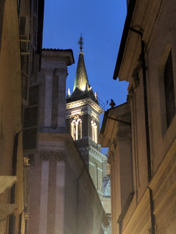 solves the mystery. We circumnavigate the outside of the Palazzo Vecchio learning of its construction in the 1400’s of the republic, and its, renovation, and takeover for private use by Cosimo di Medici in the 1500’s after the brief reign and subsequent execution of Savanarola. He points out a secret passage exit from the cellars and the elevated passage that leads from the palazzo, through the Uffizi, over the top of the shops on the Ponte Vecchio, all the way to the Palace at Pitti, which enabled the Grand Duke and courtiers to move between home and office without encountering the riffraff. We meander the narrow lanes north toward the Duomo, and Giaccomo points out the Torre dei Chechi, as an example of the dozens of tower-houses that used to exist in Florence, the beautiful Badia Fiorentina monastery with a pretty two-story cloister, and Casa Dante, where the author supposedly lived, though no one is really certain. He shows us the change in architecture between an older and expanded section of the Duomo, describes Brunelleschi's innovative method to construct the enormous dome, which simply was not otherwise possible with techniques used at the time, and details the literally lifelong work of Ghiberti in
solves the mystery. We circumnavigate the outside of the Palazzo Vecchio learning of its construction in the 1400’s of the republic, and its, renovation, and takeover for private use by Cosimo di Medici in the 1500’s after the brief reign and subsequent execution of Savanarola. He points out a secret passage exit from the cellars and the elevated passage that leads from the palazzo, through the Uffizi, over the top of the shops on the Ponte Vecchio, all the way to the Palace at Pitti, which enabled the Grand Duke and courtiers to move between home and office without encountering the riffraff. We meander the narrow lanes north toward the Duomo, and Giaccomo points out the Torre dei Chechi, as an example of the dozens of tower-houses that used to exist in Florence, the beautiful Badia Fiorentina monastery with a pretty two-story cloister, and Casa Dante, where the author supposedly lived, though no one is really certain. He shows us the change in architecture between an older and expanded section of the Duomo, describes Brunelleschi's innovative method to construct the enormous dome, which simply was not otherwise possible with techniques used at the time, and details the literally lifelong work of Ghiberti in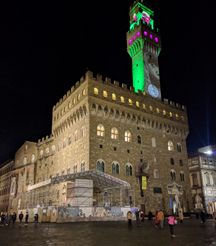 creating the two enormous gilded bronze doors of the baptistery.
creating the two enormous gilded bronze doors of the baptistery.
We wander a different twisted route through small streets and alleys back to the Palazzo Vecchio, and enter to tour its magnificent rooms and the enormous Sala de Cinquecento, where the elect 500 governed the city in the time of the republic, and where Cosimo di Medici and heirs governed as an iron ruler hundreds of years later. During the tour we learn that 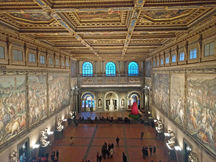 Giaccomo is a fully qualified licensed architect, but that he decided his passion was history, and leading historical architectural tours is how he will indulge that passion...he is just finishing his internship to get his guides license, and when I hand him a €20 tip, he says “are you crazy?” then grins and exclaims that it’s the very first money he’s earned from guiding!
Giaccomo is a fully qualified licensed architect, but that he decided his passion was history, and leading historical architectural tours is how he will indulge that passion...he is just finishing his internship to get his guides license, and when I hand him a €20 tip, he says “are you crazy?” then grins and exclaims that it’s the very first money he’s earned from guiding!
